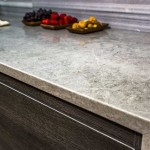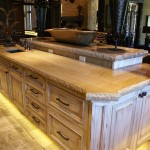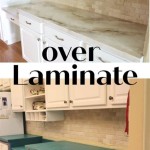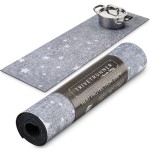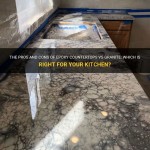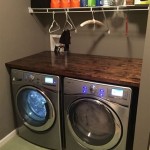Water Stains on Granite Countertops: Causes, Identification, and Remediation
Granite countertops are a popular choice in residential and commercial settings due to their durability, aesthetic appeal, and resistance to heat. However, despite their robust nature, granite surfaces are susceptible to staining, particularly from water. Understanding the causes of water stains, how to identify them accurately, and the appropriate remediation techniques are crucial for maintaining the beauty and longevity of granite countertops.
Granite is a naturally porous stone. While the sealing process aims to minimize this porosity, it doesn't eliminate it entirely. Liquids, including water, can penetrate the sealant layer and be absorbed into the stone. Over time, this absorption can lead to visible staining.
The term "water stain" can be misleading, as the visible marks are not always caused by water alone. The water often acts as a carrier for dissolved minerals, salts, or other impurities present on the countertop surface. These substances are then deposited within the granite's pores as the water evaporates, leaving behind a residue that appears as a stain.
Identifying Water Stains on Granite
Accurate identification is the first step in effectively addressing stains on granite. Water stains can manifest in various forms, and distinguishing them from other types of stains, such as oil-based or organic stains, is essential for choosing the appropriate cleaning method.
One common type of water stain appears as a light or dark ring or spot on the granite surface. This is typically caused by water that has evaporated, leaving behind mineral deposits. These deposits might originate from hard water containing calcium, magnesium, or iron.
Another type of water stain can manifest as a dull or cloudy area. This often indicates that water has penetrated the sealant and is trapped beneath the surface, causing a change in the granite's reflectivity. This type of stain may also be indicative of sealant degradation, requiring reapplication of the sealant.
Efflorescence, a white, powdery residue, can also be mistaken for a water stain. However, efflorescence is a result of salts and minerals migrating to the surface of the granite from within the stone itself or from the underlying substrate. While water facilitates this migration, the problem originates from the stone's internal composition or the surrounding environment.
To determine if a stain is indeed water-based, a simple water test can be performed. Moisten a clean cloth with water and gently wipe the affected area. If the stain temporarily disappears or becomes less noticeable when wet, it is likely a water-based stain. This is because the water is temporarily filling the pores and making the stain less visible. However, if the stain remains unchanged when wet, it may be caused by oil, grease, or other substances.
Different types of granite react differently to water and other substances. The porosity and mineral composition of the granite will affect its susceptibility to staining and the effectiveness of various cleaning methods. For example, lighter-colored granite tends to show stains more readily than darker-colored granite.
Preventing Water Stains on Granite
Prevention is the most effective strategy for minimizing the occurrence of water stains on granite countertops. Several preventative measures can be implemented to protect the granite surface and maintain its appearance.
Regular sealing is crucial for preventing water penetration. Granite countertops should be sealed periodically, according to the manufacturer's recommendations or the advice of a stone care professional. The frequency of sealing depends on several factors, including the type of granite, the quality of the sealant, and the level of countertop usage. A simple water test can be used to assess the effectiveness of the sealant. If water beads up on the surface, the sealant is likely still effective. If the water soaks in quickly, it is time to reapply the sealant.
Prompt cleanup of spills is essential. Water, juice, coffee, and other liquids should be wiped up immediately to prevent them from penetrating the granite. Avoid allowing liquids to sit on the surface for extended periods, as this increases the likelihood of staining.
Use coasters and placemats under glasses, cups, and plates to protect the granite surface from water rings and other stains. These barriers will prevent liquids from coming into direct contact with the countertop.
Avoid using abrasive cleaners or scouring pads, as these can scratch the granite surface and damage the sealant. Use a pH-neutral cleaner specifically designed for granite. Harsh chemicals, such as bleach or ammonia, can also damage the granite and should be avoided.
Consider installing a water softener to reduce the mineral content of the water supply. Hard water can leave mineral deposits on the granite surface, contributing to staining. A water softener will remove calcium, magnesium, and other minerals from the water, reducing the risk of these deposits forming.
Dry the countertop surface after each use. This will prevent water from lingering on the surface and potentially soaking into the granite. Use a soft, absorbent cloth to dry the countertop after wiping up spills or cleaning.
Remediating Water Stains on Granite
Despite preventative measures, water stains may still occur on granite countertops. Several remediation techniques can be employed to remove these stains and restore the granite's appearance.
For light water stains, a simple paste of baking soda and water may be effective. Mix baking soda with enough water to form a thick paste. Apply the paste to the stain and allow it to sit for several hours or overnight. Then, wipe the paste away with a damp cloth and dry the surface thoroughly.
For more stubborn water stains, a poultice may be necessary. A poultice is a paste-like substance that is applied to the stain and covered with plastic wrap to draw out the stain. Several different poultice recipes can be used, depending on the type of stain. For water stains, a poultice made from diatomaceous earth and water or hydrogen peroxide may be effective.
To create a poultice, mix the chosen absorbent material (such as diatomaceous earth) with the liquid (such as water or hydrogen peroxide) to form a thick paste. Apply the poultice to the stain, covering it completely. Cover the poultice with plastic wrap and tape the edges to seal it. Allow the poultice to sit for 24 to 48 hours, or longer if necessary. Remove the plastic wrap and allow the poultice to dry completely. Scrape off the dried poultice and wipe the area with a damp cloth. Dry the surface thoroughly. Repeat the process if necessary.
If the water stain is caused by hard water deposits, a commercially available hard water stain remover may be used. Follow the manufacturer's instructions carefully. Test the product in an inconspicuous area first to ensure that it does not damage the granite.
If the sealant is damaged or degraded, it may be necessary to reapply the sealant. Clean the granite surface thoroughly and allow it to dry completely. Apply the sealant according to the manufacturer's instructions. Allow the sealant to cure for the recommended time before using the countertop.
For severe or persistent water stains, it may be necessary to consult a professional stone restoration company. These professionals have the expertise and equipment to remove even the most stubborn stains without damaging the granite.
When selecting a cleaning product or remediation technique, it is important to consider the type of granite and the nature of the stain. Always test the product or technique in an inconspicuous area first to ensure that it does not damage the granite. Avoid using harsh chemicals or abrasive materials, as these can scratch or etch the granite surface.
Proper maintenance and care are essential for preserving the beauty and longevity of granite countertops. By understanding the causes of water stains, implementing preventative measures, and using appropriate remediation techniques, homeowners and commercial property managers can effectively manage these stains and enjoy the benefits of granite countertops for many years.

How To Clean Water Stains From Granite A Guide By Bc Stone

I Left Some Wet Rags On My Granite Countertops This Stain Appeared

How To Remove Hard Water Stains From Granite Countertops Professional Results At Home

How To Remove Stains From Granite Stone Care International

Smells Like Food In Here Clean Rust Stain From Granite Countertop

Staining Tests On Granite Marble Great Lakes

How To Clean Seal And Polish Granite Countertops Pro Housekeepers

How Can You Remove Water Stains From Granite In 2025 Marble Com

Removing Hard Water Stains On Granite Countertops
How To Remove Water Stains From Granite Howstuffworks
See Also

